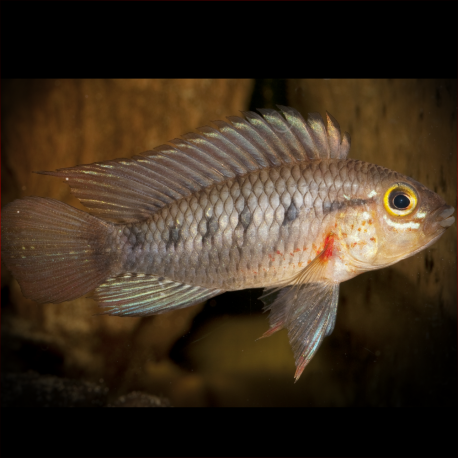More info
Datasheet
| Minimum Tank Size | 80 litres / 21.13 US gallons |
| Maximum Size | 5.0cm / 1.97inches |
General Description
Apistogramma Cinilabra, also known as Ash Lipped Apisto, is a cichlid species belonging to the Perciformes order. They are characterized by disproportionately high bodies and short caudal peduncles. The males of this species display unique ash-grey lips, red pectoral bases, and red spots on the chest. With over 70 species in the Apistogramma genus, they are among the most speciose South American cichlids.
Aquarium Setup
For Apistogramma Cinilabra, a tank size of at least 80 litres is recommended. They thrive in setups with adequate cover, such as ceramic flowerpots, plastic piping, and natural structures like wood roots. A soft, sandy substrate, wood branches, and dried leaf litter provide shelter and spawning sites. Dim lighting and aquatic plants like Microsorum and Cryptocoryne are suitable. Filtration should not be overly strong, as these fish are sensitive to organic waste fluctuations.
Behaviour
Ash Lipped Apistos are generally peaceful but can exhibit bullyish behavior towards conspecifics in confined spaces. They fare well in community tanks with small characins and rasboras. Wild examples are best kept alone or with small dither fishes to avoid aggression. Males establish territories during breeding and can be picky with mates. Post-spawning, males typically return to their territories, while females guard the eggs and fry.
Feeding and Diet
Apistogramma species are primarily carnivorous, feeding on benthic invertebrates in the wild. In captivity, they should be offered live or frozen foods like Artemia and Daphnia regularly. Most species can also adapt to dried foods, with pelleted products preferred. Microbe colonies from decomposing leaf litter can serve as a secondary food source for fry.
Reproduction & Dimorphism
These fish are substrate spawners, laying eggs in crevices or cavities within the tank. Sexually mature males become aggressive towards other males but tolerate multiple females. Males are larger and more colorful, with extended fins and ash-grey lips. Females display a bright yellow coloration with black markings during spawning and brood care.
Habitat and Distribution
Apistogramma Cinilabra is found in shallow, blackwater pools near Iquitos and Nauta in the Loreto district of Peru. Their habitat includes leaf litter, fine white sand substrate, and woody debris in heavily forested areas. Sympatric fish species in their environment include Apistogramma Atahualpa, Apistogramma Eremnopyge, Pyrrhulina cf. Spilota, and an unidentified Rivulus sp.

